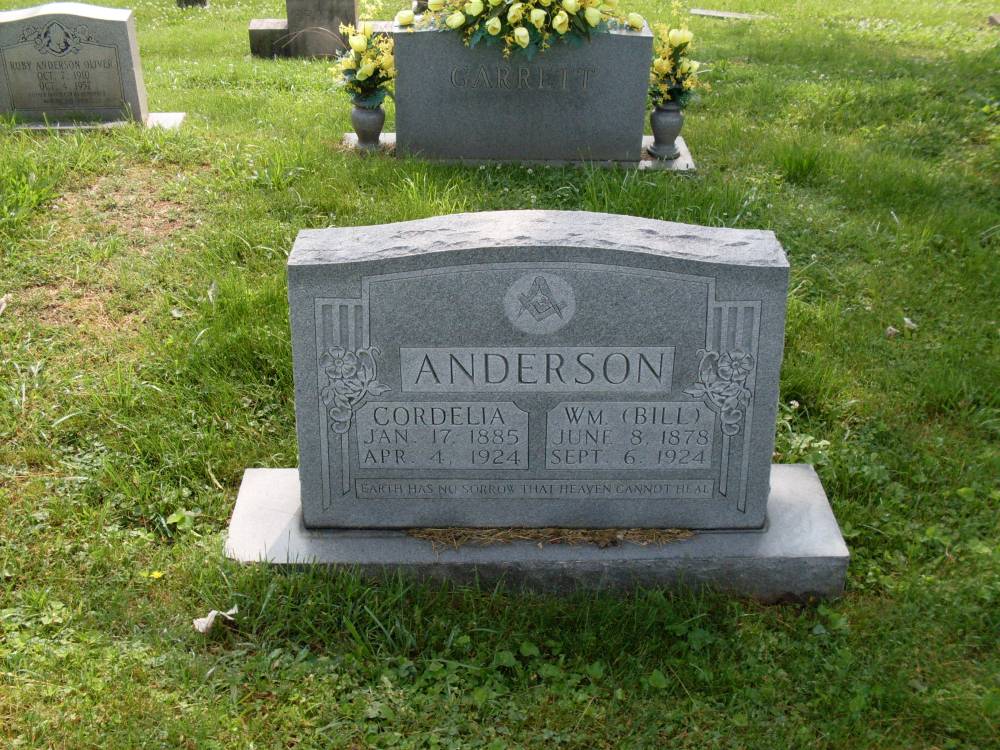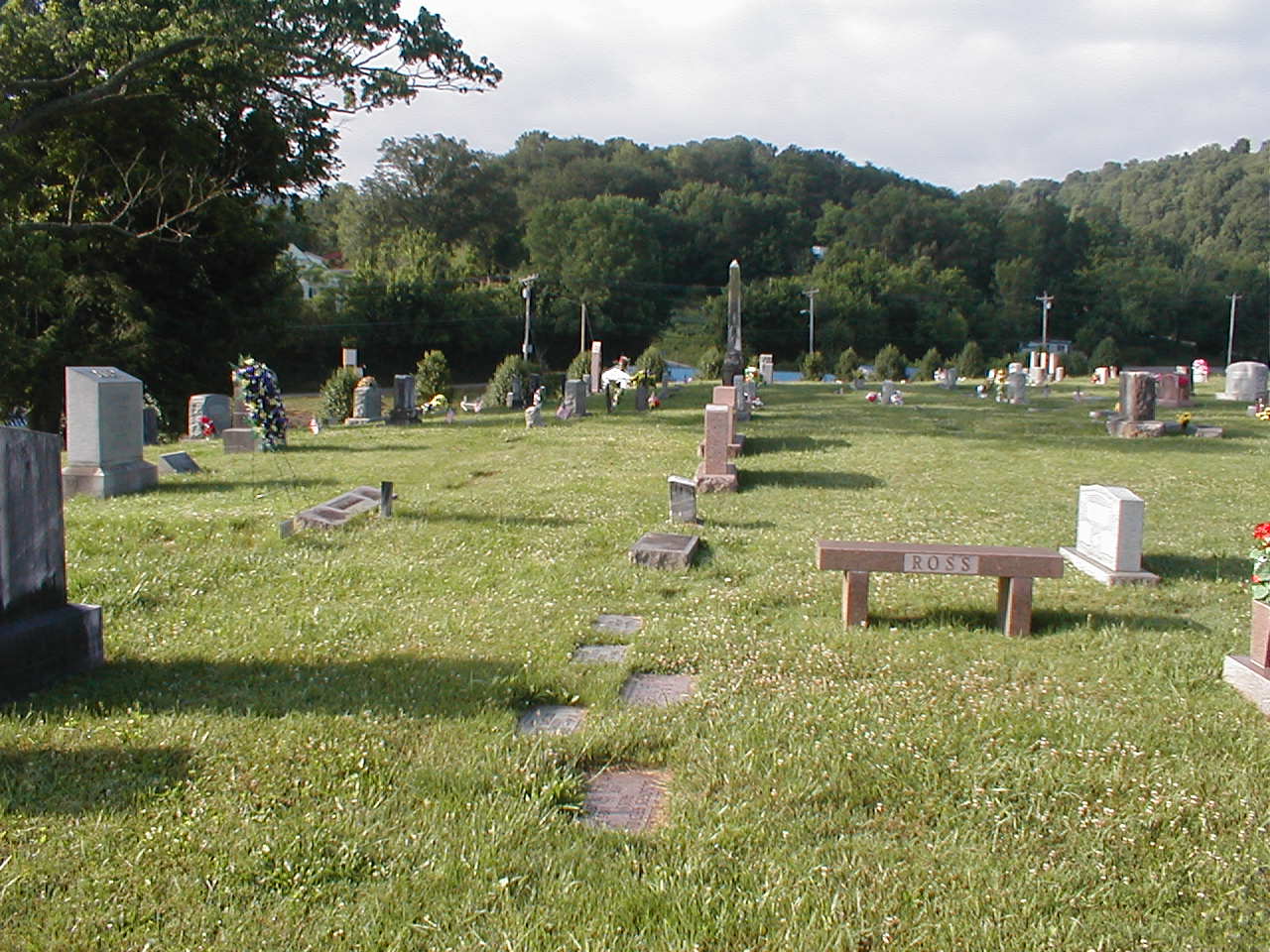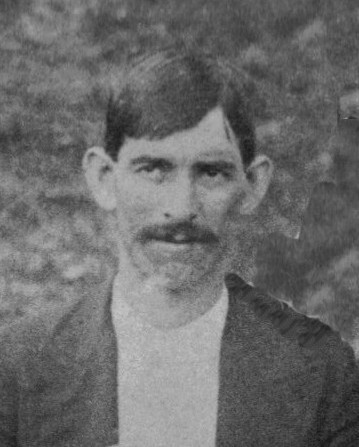Married Cordelia Ann Cordell daughter of Joseph Martin Cordell and Nancy Elizabeth Serepta Strunk
Children:
Ida Elizabeth Anderson m. Garland Eugene Vermillion, Sr
Edna Barbara Anderson m. Hazel Gladys Peace
Florence Belle Anderson m. Paul Jones
Mary Llewellyn Anderson m. Gilmore Archer
Sarah Helen Anderson m. Walter Moore
Nancy Ruby Anderson m. 1)Bud Isaac Oliver 2)Forney Jordan
Margaret Mae Anderson m. Winford Frederick
Mildred Irene Anderson m. David Franklin Mullins
Grandchildren:
Ruth Marie Vermillion (never married)
Lillian Jeanette Vermillion m. Samuel C Davenport
Mary Jane Vermillion m. Ralph D Church
Charles William Vermillion (never married)
Elizabeth Josephine Vermillion (never married)
Garland Eugene Vermillion, Jr m. Barbara ?
Robert Jasper Vermillion m. Charlene Hays
James Willard Peace
Imogene Peace (twin)
Norma Jean Peace (twin)m. ? Lawson
Joe Matt Peace m. 1)Allie Gray Edwards 2)Ruth E Sizemore
Thomas Glendon Peace m. Rosemarie Mariana Schwarz
Mary Elizabeth Peace m.
Patricia Faye Peace
Dorotha Pauline Peace m. Wayne Hatmaker
Cherry Lee Peace m. Chester Frank Guiher,II
Cordilia Peace
Princess Pauline Jones m. 1)Thomas Wayne Garrett 2)Harold Irwin Moon
Sidney William Jones m. Jean Porter
Patsy Ruth Jones m. William Smith
Harvey Jasper Archer n. Edith ?
Albert Marion Archer m. Ruth Marie Hagerhjelm
Frankie Vivian Moore m. ? McNealey
Walter Jasper Moore
John Thomas Moore
Cordelia Ann Moore m. ? Lay
Donald Ray Moore
Virginia Jacqueline Oliver m. Norman Estill Jones
George Joseph Oliver m. Jane Leach
Kenneth Gene Oliver m. Colena Douglas
Mildred Louise Oliver m. HL Atkisson
Roger Oliver, Sr
Grant Darvon Frederick m. 1)Helen 2)Norma 3)Sandy J Rivero 4)Carma S Katona
Philip Jerry Frederick
Joyce Phyllis Frederick
Etta Karolyn Mullins m. Roger Lloyd Gregory
Philip Wayne Mullins
Mae Searcy Mullins m. Willie Logan New
David Ancil Mullins
Siblings:
Isham Anderson
David Anderson m. 1)Senia Ann Gilreath 2)Sarah Jane ? 3)? Chitwood 4)Martha Stephens
John Anderson m. Hannah Armelda Gilreath
James R Kearns Anderson m. Sarah E Chitwood
Simpson Anderson m. 1)Emma Nolie Stephens 2)Nancy Creekmore
Jacob C Anderson m. Lucinda Chitwood
Campbell H Anderson m. Barbara Siler
Andrew Jackson Anderson m. Sarah Baker
Millie Anderson m. Green Berry Davenport
Margaret Anderson m. Alvas Thomas
Nancy J Anderson m. Moses Crabtree
William Jasper "Bill" Anderson, was a tall, muscular man. He was a blacksmith. His wife, Cordelia, had asthma and took medicines for her asthmatic condition. Cordelia's physician was Dr. William Gaylor (buried in this same cemetery). Bill had asked Doc Gaylor not to give Cordelia a certain medicine for asthma because she would come near death every time to she took this medication. Cordelia died April 4, 1924. Leaving 8 girls. The youngest being, Mildred, age 5. Bill did the best he could to care for his girls during the summer of 1924. On September 6, 1924, Bill took his 5 yr old daughter, Mildred, and went into town at Jellico. Bill happened to run into the Doc and confronted Doc Gaylor about his continuing the medicine with Cordelia after he had asked the Doc not to prescribe it for her. Bill was irate. That same day after seeing Bill, Doc Gaylor had Bill's car towed which enraged Bill when he found out. When he went to pick up his car, Doc Gaylor was there and the two men engaged in a fight. Bill being tall and muscular was pulled off the Doc by several men. Doc Gaylor then pulled out a scalpel from his jacket and stabbed Bill in the heart while his arms where pulled back by the men and chest exposed. My grandmother, Mildred, witnessed this horrific scene at the age of 5 years. Mildred and her dying Papa were taken to her grandmother Anderson's home where Bill bleed and died on his mother's front porch. Mildred and Margaret being the youngest were sent to an orphanage in Tiffin, OH. Bill being a blacksmith was a member of the United American Mechanics. The girls were eligible to go to the Junior Order United American Mechanics Home in Tiffin, OH. Mildred was sent first and Margaret came later but did not stay to graduate.
Mildred was known as "Mid" while in the orphanage in OH
National Orphans' Home, Junior Order United American Mechanics
Seneca County
#90001499 Historic Site
AKA Junior Home
600 N. River Rd., Tiffin
(6480 acres, 34 buildings)
Historic Significance: Event, Architecture/Engineering
Architect, builder, or engineer: Unknown
Architectural Style: Bungalow/Craftsman, Gothic, Other
Area of Significance: Education, Architecture, Social History
Period of Significance: 1875-1899, 1900-1924, 1925-1949
Owner: State of OH
Historic Function: Domestic, Education
Historic Sub-function: Institutional Housing, School
Current Function: Agriculture/Subsistence, Health Care
Current Sub-function: Agricultural Fields, Hospital
The Jr. Home was maintained by The Junior Order of United American Mechanics (Jr OUAM), an organization which began as the native American Association, a preeminently American society that had it's origin in the anti-foreign movement of the late 18th and early 19th centuries. The Jr. Order of United American Mechanics was organized in May, 1853, in Philadelphia, PA, and quickly grew into a nationwide brotherhood inspired by the principles of Virtue, Liberty, Patriotism. With a total of 2,950 councils, the Jr. Order in 1930 was given the distinction of being called the leading Patriotic Order of the United States.
The Jr. Home Orphanage was established in 1896 and closed in 1944. The orphanage grew from a single farm residence into a self-supporting community, populated by as many as 1,200 residents during its peak years of the 1930-1937 area. As a self-sufficient community, the complex included a wide range of structures; residence cottages, a chapel, a gymnasium, grade and high schools, a vocational (trade) school, a hospital, a central dining hall, a bank and a post office, a nursery, a library, a laundry, a cannery, a power plant and an administrative building. All structures were brick with stone or concrete trim, except the cannery, which was stucco covered, the greenhouse, which was glass, and the chapel, which was constructed of gray limestone.
By 1930, all the major campus buildings had been erected, numbering approximately forty (40) buildings. The residential cottages were planned according to the three (3) distinct architectural designs over a period of thirty (30) years from 1897 – 1925. Each was sponsored by and named for various state councils of The Junior Order of United American Mechanics. The self-sufficiency aspect of the Junior Home is evident in the construction of the Kentucky Memorial Hospital in 1908. Until 1928, the Junior Home hospital was the only hospital in the area and was opened to serve the local citizens of Tiffin, Ohio and surrounding communities until 1915. The canning factory was constructed in 1913 to can the surplus fruits and vegetables from the ever-expanding farm. The cannery was valuable to the Home, both financially and educationally, as courses in food preservation were offered as part of the Junior Home Vocational program. In 1920, for example, the canning factory packed 995 cans of pears, 15,140 cans of corn, 2,673 cans of beans, as well as large quantities of tomatoes and kraut. Other vocational training consisted of home economics, auto mechanics, art fiber weaving, baking, cement construction, electrical work, farming, dairying, animal husbandry, greenhouse and garden, laundering, motion picture operation, painting, printing, plumbing, practical nursing, stationery secretary, engineering, shoe repair, woodworking, carpentry, newspaper work, proof reading, instrumental music, sewing, store clerking, and cooking.
When the Tiffin, Ohio Junior Order Home took in more children than its capacity, the Juniors pondered the possibility of building a branch Home. The idea failed twice during the National Convention, once in 1903, and again in 1921. The National Convention was only held every two years, and the next time it met in 1923 the Tiffin Home had over 200 children more than its capacity. The North Carolina Juniors, having the highest Junior Order membership, were eager to have a branch Home in their state. They offered to fund this project considerably. It was decided that a branch Home would be built in Lexington, North Carolina.
Married Cordelia Ann Cordell daughter of Joseph Martin Cordell and Nancy Elizabeth Serepta Strunk
Children:
Ida Elizabeth Anderson m. Garland Eugene Vermillion, Sr
Edna Barbara Anderson m. Hazel Gladys Peace
Florence Belle Anderson m. Paul Jones
Mary Llewellyn Anderson m. Gilmore Archer
Sarah Helen Anderson m. Walter Moore
Nancy Ruby Anderson m. 1)Bud Isaac Oliver 2)Forney Jordan
Margaret Mae Anderson m. Winford Frederick
Mildred Irene Anderson m. David Franklin Mullins
Grandchildren:
Ruth Marie Vermillion (never married)
Lillian Jeanette Vermillion m. Samuel C Davenport
Mary Jane Vermillion m. Ralph D Church
Charles William Vermillion (never married)
Elizabeth Josephine Vermillion (never married)
Garland Eugene Vermillion, Jr m. Barbara ?
Robert Jasper Vermillion m. Charlene Hays
James Willard Peace
Imogene Peace (twin)
Norma Jean Peace (twin)m. ? Lawson
Joe Matt Peace m. 1)Allie Gray Edwards 2)Ruth E Sizemore
Thomas Glendon Peace m. Rosemarie Mariana Schwarz
Mary Elizabeth Peace m.
Patricia Faye Peace
Dorotha Pauline Peace m. Wayne Hatmaker
Cherry Lee Peace m. Chester Frank Guiher,II
Cordilia Peace
Princess Pauline Jones m. 1)Thomas Wayne Garrett 2)Harold Irwin Moon
Sidney William Jones m. Jean Porter
Patsy Ruth Jones m. William Smith
Harvey Jasper Archer n. Edith ?
Albert Marion Archer m. Ruth Marie Hagerhjelm
Frankie Vivian Moore m. ? McNealey
Walter Jasper Moore
John Thomas Moore
Cordelia Ann Moore m. ? Lay
Donald Ray Moore
Virginia Jacqueline Oliver m. Norman Estill Jones
George Joseph Oliver m. Jane Leach
Kenneth Gene Oliver m. Colena Douglas
Mildred Louise Oliver m. HL Atkisson
Roger Oliver, Sr
Grant Darvon Frederick m. 1)Helen 2)Norma 3)Sandy J Rivero 4)Carma S Katona
Philip Jerry Frederick
Joyce Phyllis Frederick
Etta Karolyn Mullins m. Roger Lloyd Gregory
Philip Wayne Mullins
Mae Searcy Mullins m. Willie Logan New
David Ancil Mullins
Siblings:
Isham Anderson
David Anderson m. 1)Senia Ann Gilreath 2)Sarah Jane ? 3)? Chitwood 4)Martha Stephens
John Anderson m. Hannah Armelda Gilreath
James R Kearns Anderson m. Sarah E Chitwood
Simpson Anderson m. 1)Emma Nolie Stephens 2)Nancy Creekmore
Jacob C Anderson m. Lucinda Chitwood
Campbell H Anderson m. Barbara Siler
Andrew Jackson Anderson m. Sarah Baker
Millie Anderson m. Green Berry Davenport
Margaret Anderson m. Alvas Thomas
Nancy J Anderson m. Moses Crabtree
William Jasper "Bill" Anderson, was a tall, muscular man. He was a blacksmith. His wife, Cordelia, had asthma and took medicines for her asthmatic condition. Cordelia's physician was Dr. William Gaylor (buried in this same cemetery). Bill had asked Doc Gaylor not to give Cordelia a certain medicine for asthma because she would come near death every time to she took this medication. Cordelia died April 4, 1924. Leaving 8 girls. The youngest being, Mildred, age 5. Bill did the best he could to care for his girls during the summer of 1924. On September 6, 1924, Bill took his 5 yr old daughter, Mildred, and went into town at Jellico. Bill happened to run into the Doc and confronted Doc Gaylor about his continuing the medicine with Cordelia after he had asked the Doc not to prescribe it for her. Bill was irate. That same day after seeing Bill, Doc Gaylor had Bill's car towed which enraged Bill when he found out. When he went to pick up his car, Doc Gaylor was there and the two men engaged in a fight. Bill being tall and muscular was pulled off the Doc by several men. Doc Gaylor then pulled out a scalpel from his jacket and stabbed Bill in the heart while his arms where pulled back by the men and chest exposed. My grandmother, Mildred, witnessed this horrific scene at the age of 5 years. Mildred and her dying Papa were taken to her grandmother Anderson's home where Bill bleed and died on his mother's front porch. Mildred and Margaret being the youngest were sent to an orphanage in Tiffin, OH. Bill being a blacksmith was a member of the United American Mechanics. The girls were eligible to go to the Junior Order United American Mechanics Home in Tiffin, OH. Mildred was sent first and Margaret came later but did not stay to graduate.
Mildred was known as "Mid" while in the orphanage in OH
National Orphans' Home, Junior Order United American Mechanics
Seneca County
#90001499 Historic Site
AKA Junior Home
600 N. River Rd., Tiffin
(6480 acres, 34 buildings)
Historic Significance: Event, Architecture/Engineering
Architect, builder, or engineer: Unknown
Architectural Style: Bungalow/Craftsman, Gothic, Other
Area of Significance: Education, Architecture, Social History
Period of Significance: 1875-1899, 1900-1924, 1925-1949
Owner: State of OH
Historic Function: Domestic, Education
Historic Sub-function: Institutional Housing, School
Current Function: Agriculture/Subsistence, Health Care
Current Sub-function: Agricultural Fields, Hospital
The Jr. Home was maintained by The Junior Order of United American Mechanics (Jr OUAM), an organization which began as the native American Association, a preeminently American society that had it's origin in the anti-foreign movement of the late 18th and early 19th centuries. The Jr. Order of United American Mechanics was organized in May, 1853, in Philadelphia, PA, and quickly grew into a nationwide brotherhood inspired by the principles of Virtue, Liberty, Patriotism. With a total of 2,950 councils, the Jr. Order in 1930 was given the distinction of being called the leading Patriotic Order of the United States.
The Jr. Home Orphanage was established in 1896 and closed in 1944. The orphanage grew from a single farm residence into a self-supporting community, populated by as many as 1,200 residents during its peak years of the 1930-1937 area. As a self-sufficient community, the complex included a wide range of structures; residence cottages, a chapel, a gymnasium, grade and high schools, a vocational (trade) school, a hospital, a central dining hall, a bank and a post office, a nursery, a library, a laundry, a cannery, a power plant and an administrative building. All structures were brick with stone or concrete trim, except the cannery, which was stucco covered, the greenhouse, which was glass, and the chapel, which was constructed of gray limestone.
By 1930, all the major campus buildings had been erected, numbering approximately forty (40) buildings. The residential cottages were planned according to the three (3) distinct architectural designs over a period of thirty (30) years from 1897 – 1925. Each was sponsored by and named for various state councils of The Junior Order of United American Mechanics. The self-sufficiency aspect of the Junior Home is evident in the construction of the Kentucky Memorial Hospital in 1908. Until 1928, the Junior Home hospital was the only hospital in the area and was opened to serve the local citizens of Tiffin, Ohio and surrounding communities until 1915. The canning factory was constructed in 1913 to can the surplus fruits and vegetables from the ever-expanding farm. The cannery was valuable to the Home, both financially and educationally, as courses in food preservation were offered as part of the Junior Home Vocational program. In 1920, for example, the canning factory packed 995 cans of pears, 15,140 cans of corn, 2,673 cans of beans, as well as large quantities of tomatoes and kraut. Other vocational training consisted of home economics, auto mechanics, art fiber weaving, baking, cement construction, electrical work, farming, dairying, animal husbandry, greenhouse and garden, laundering, motion picture operation, painting, printing, plumbing, practical nursing, stationery secretary, engineering, shoe repair, woodworking, carpentry, newspaper work, proof reading, instrumental music, sewing, store clerking, and cooking.
When the Tiffin, Ohio Junior Order Home took in more children than its capacity, the Juniors pondered the possibility of building a branch Home. The idea failed twice during the National Convention, once in 1903, and again in 1921. The National Convention was only held every two years, and the next time it met in 1923 the Tiffin Home had over 200 children more than its capacity. The North Carolina Juniors, having the highest Junior Order membership, were eager to have a branch Home in their state. They offered to fund this project considerably. It was decided that a branch Home would be built in Lexington, North Carolina.
Family Members
-
![]()
David Anderson
1859–1922
-
![]()
John Anderson
1861–1940
-
![]()
James R Anderson
1863–1907
-
![]()
Jacob Clay "Jake" Anderson
1868–1942
-
![]()
Campbell "Cam" Anderson
1870–1937
-
![]()
Andrew Jackson "Jack" Anderson
1872–1944
-
![]()
Millie Anderson Davenport
1874–1924
-
Margaret Anderson Thomas
1876–1942
-
![]()
Nancy "Nannie" Anderson Crabtree
1884 – unknown
Sponsored by Ancestry
Advertisement
Explore more
Sponsored by Ancestry
Advertisement






















